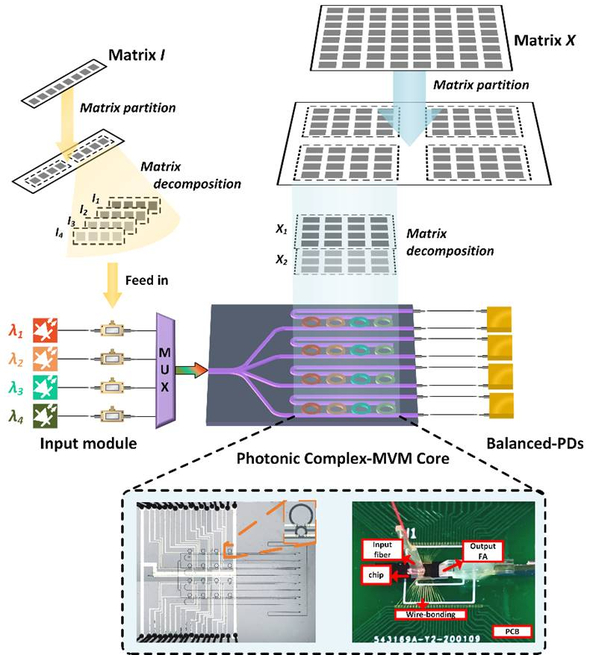By combating the inherent limitations of electrons, optical computing utilizes photons rather than electrons to conduct computations, which can substantially enhance the speed and energy performance of computations.
 Working principle of the photonic complex matrix-vector multiplier chip. Image Credit: Junwei Cheng, Yuhe Zhao, Wenkai Zhang, Hailong Zhou, Dongmei Huang, Qing Zhu, Yuhao Guo, Bo Xu, Jianji Dong, Xinliang Zhang.
Working principle of the photonic complex matrix-vector multiplier chip. Image Credit: Junwei Cheng, Yuhe Zhao, Wenkai Zhang, Hailong Zhou, Dongmei Huang, Qing Zhu, Yuhao Guo, Bo Xu, Jianji Dong, Xinliang Zhang.
The engagement of light and matter is the fundamental principle of optical computing. Matrix computing has evolved into one of the most broadly used and essential information processing tools in science and engineering, contributing a large number of computational tasks to most signal processing, such as discrete Fourier transforms and convolution operations.
Matrix multiplication consumes the majority of computational resources as the fundamental building block of artificial neural networks (ANNs). Simple matrix multiplications involve a large number of transistors collaborating together due to the characteristics of electronic components, whereas matrix multiplications can be easily applied by basic photonic components such as a microring, Mach Zehnder interferometer (MZI) and diffractive plane.
As a result, optical computing is many orders of magnitude faster than electronic computing and utilizes significantly less power. The conventional incoherent matrix-vector multiplication technique, on the other hand, is limited to real-valued processes and does not function properly well with complex-valued neural networks or discrete Fourier transforms.
Huazhong University of Science and Technology (HUST) scientists led by Professor Jianji Dong have presented a photonic complex matrix-vector multiplier chip that can assist arbitrary large-scale and complex-valued matrix multiplication operations.
The chip overcomes the bottleneck that conventional non-coherent optical computing schemes face when performing arbitrary large-scale complex-valued matrix multiplications, as well as enabling artificial intelligence implementations like discrete Fourier transform, discrete cosine transform, Walsh transform, and image convolution.
Their plan is to create smart matrix decomposition and matrix partitioning algorithms for the microring array architecture to prolong matrix multiplications from real to complex domains and from small to large scales.
The scientists conclusively demonstrated numerous typical artificial intelligence applications, illustrating the photonic complex matrix-vector multiplier chip’s promising applications in artificial intelligence computing.
Journal Reference:
Cheng, J., et al. (2022) A small microring array that performs large complex-valued matrix-vector multiplication. Frontiers of Optoelectronics. doi.org/10.1007/s12200-022-00009-4.